Abstract
Experimental myocardial ischemia produced in dogs by proximal left anterior descending coronary artery ligation is accompanied by relatively rapid (1 h) increases in the number of (-) [3H]dihydroalprenolol binding sites without changing their dissociation constants in ischemic left ventricular tissue. The changes, persist for at least 8 h and are accompanied by marked decreases in myocardial tissue ischemic region norepinephrine content. In contrast, in the same canine model 1 h of proximal left anterior descending coronary artery ligation did not result in a significant change in the number of [3H]quinuclidynl benzilate binding sites of their dissociation constants. However, the number of [3H]quinuclidynl benzilate binding sites (muscarinic cholinergic receptors) are 50--70% greater than (-) [3H]dihydroalprenolol binding sites (beta adrenergic receptors) in canine left ventricular tissue. Thus, the data suggest that proximal left anterior descending coronary artery occlusion for 1 h significantly increases the number of beta adrenergic receptors in ischemic left ventricular tissue without changing the number of muscarinic cholinergic receptors. Whether the ischemia-produced increase in cardiac beta-receptor content is causally related to increased cyclic AMP levels that develop in ischemic tissue and/or an etiologic factor in arrhythmias originating from ischemic myocardial tissue will have to be determined in additional studies.
Full text
PDF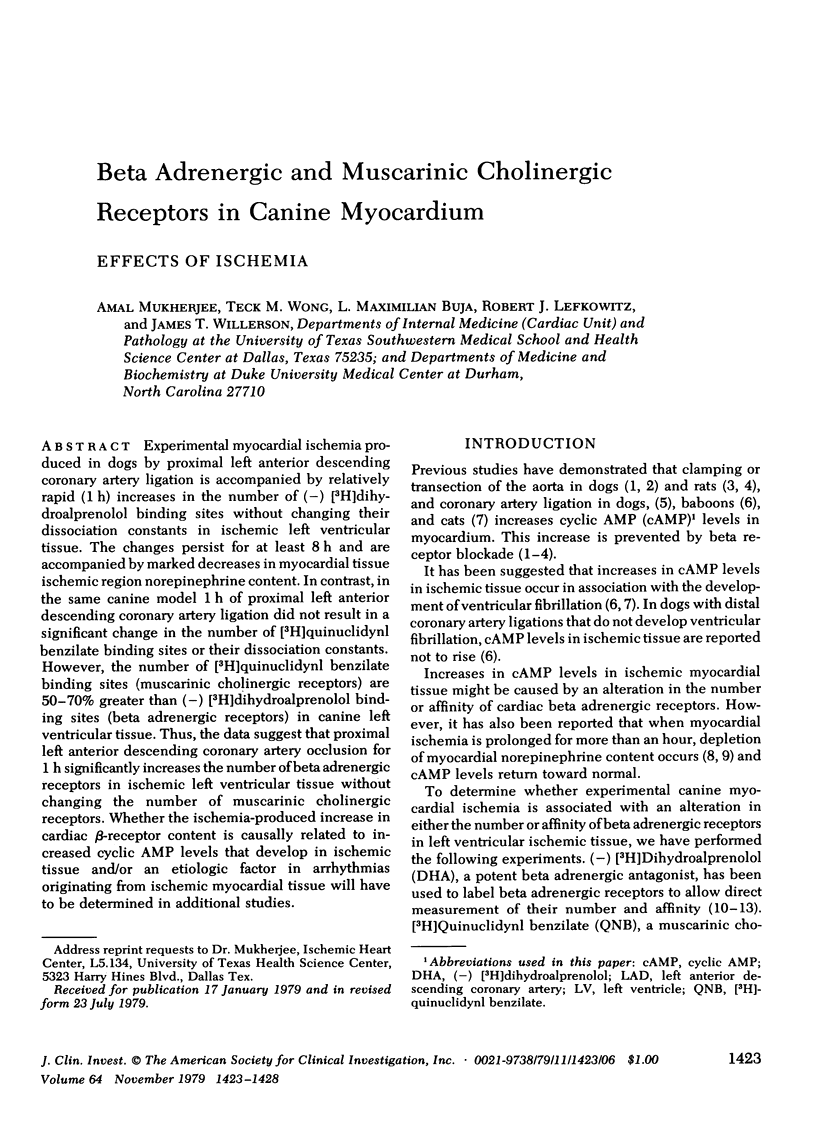
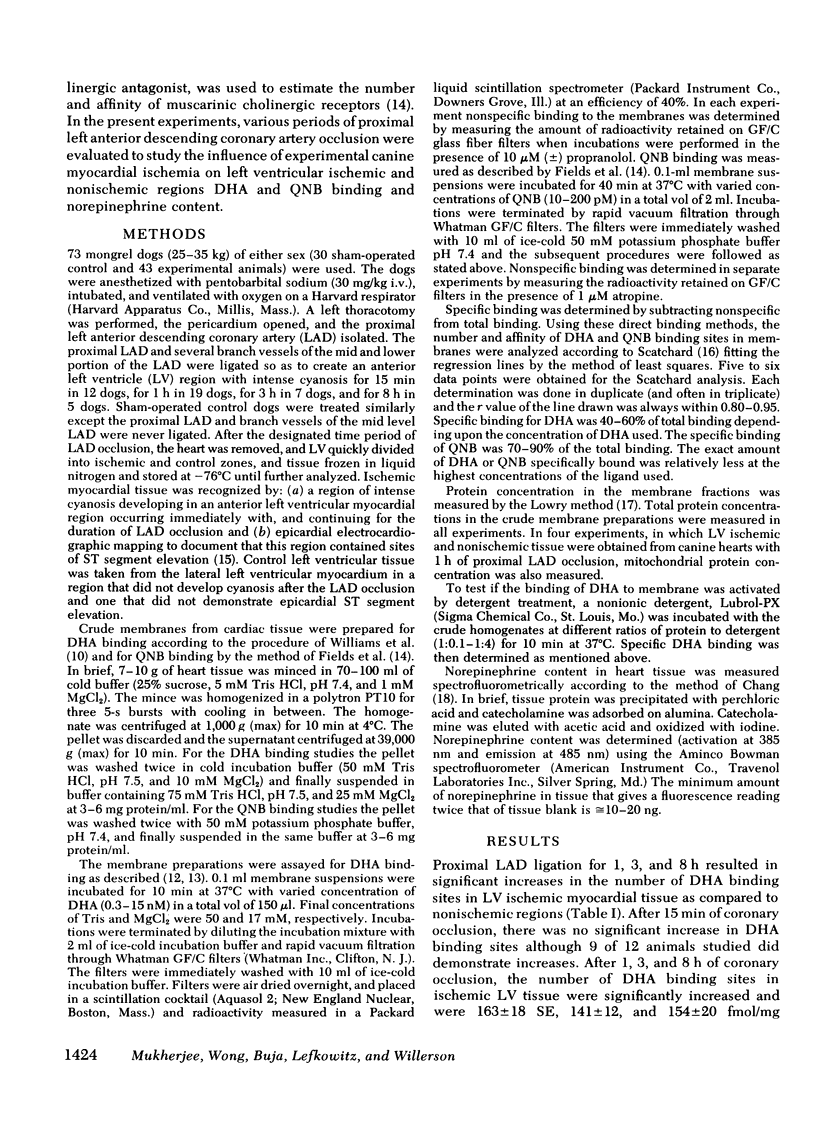
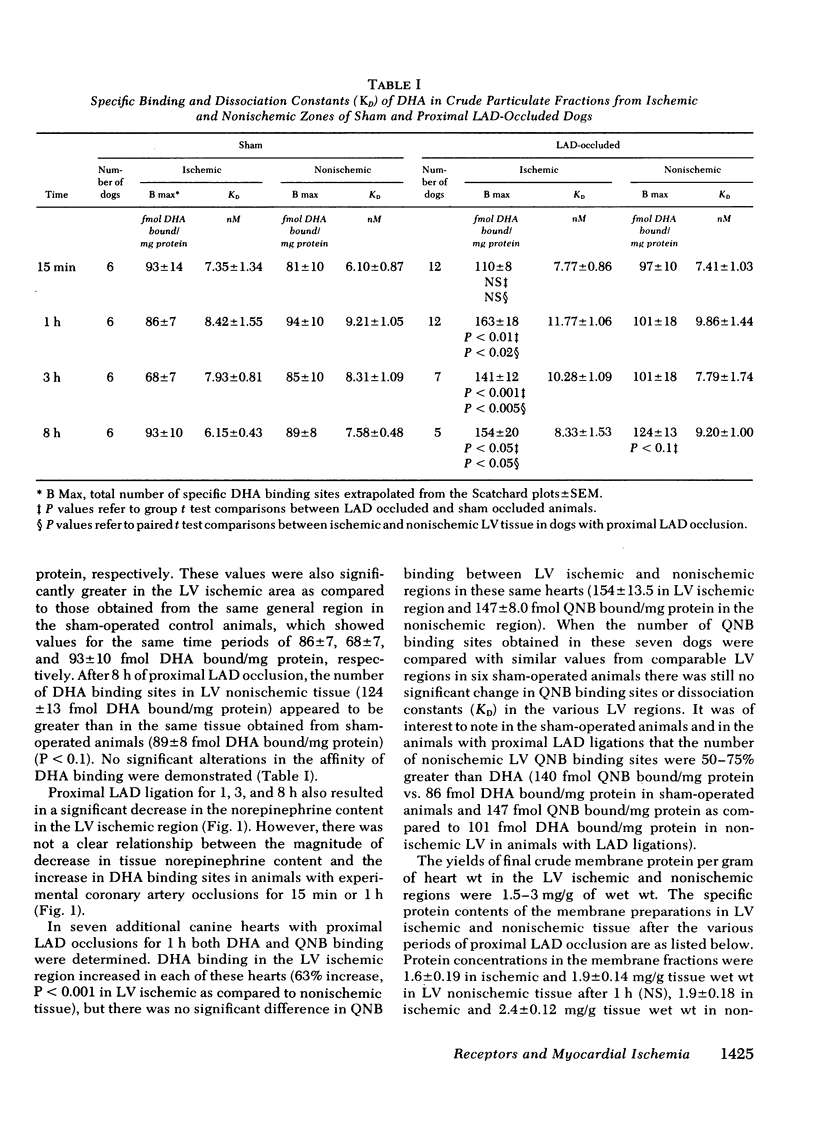
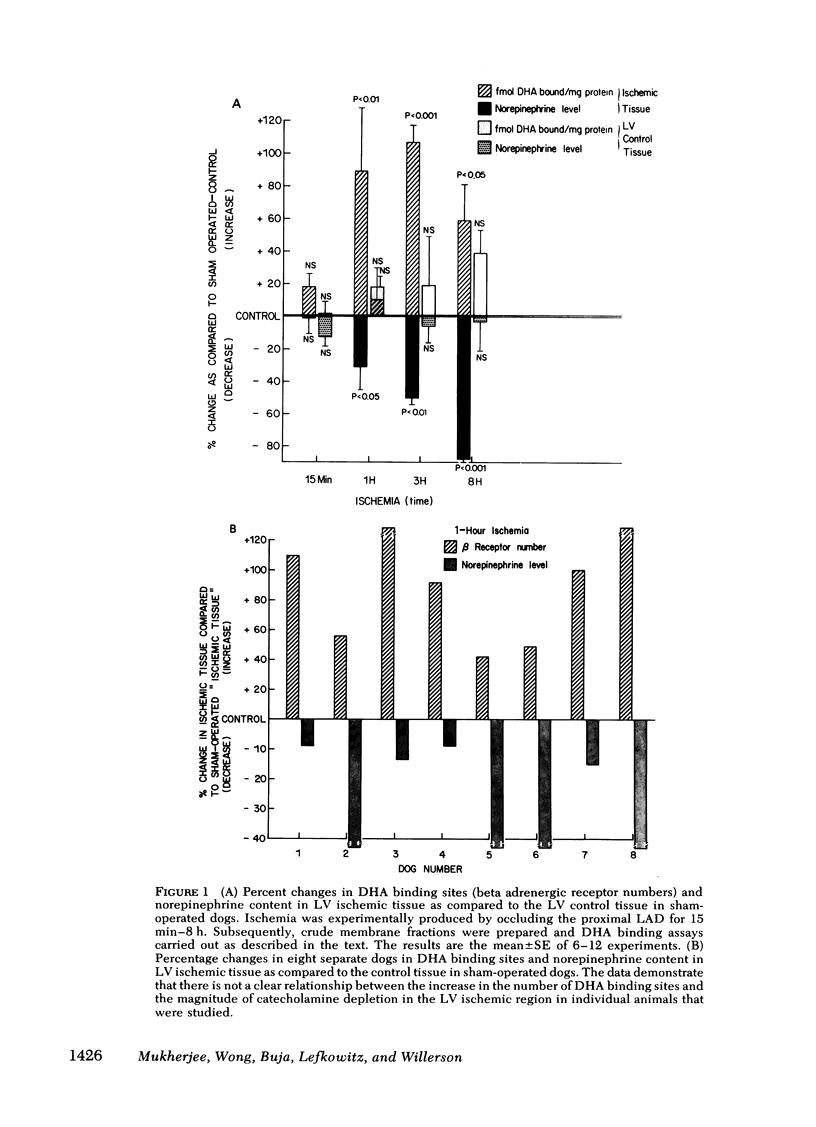
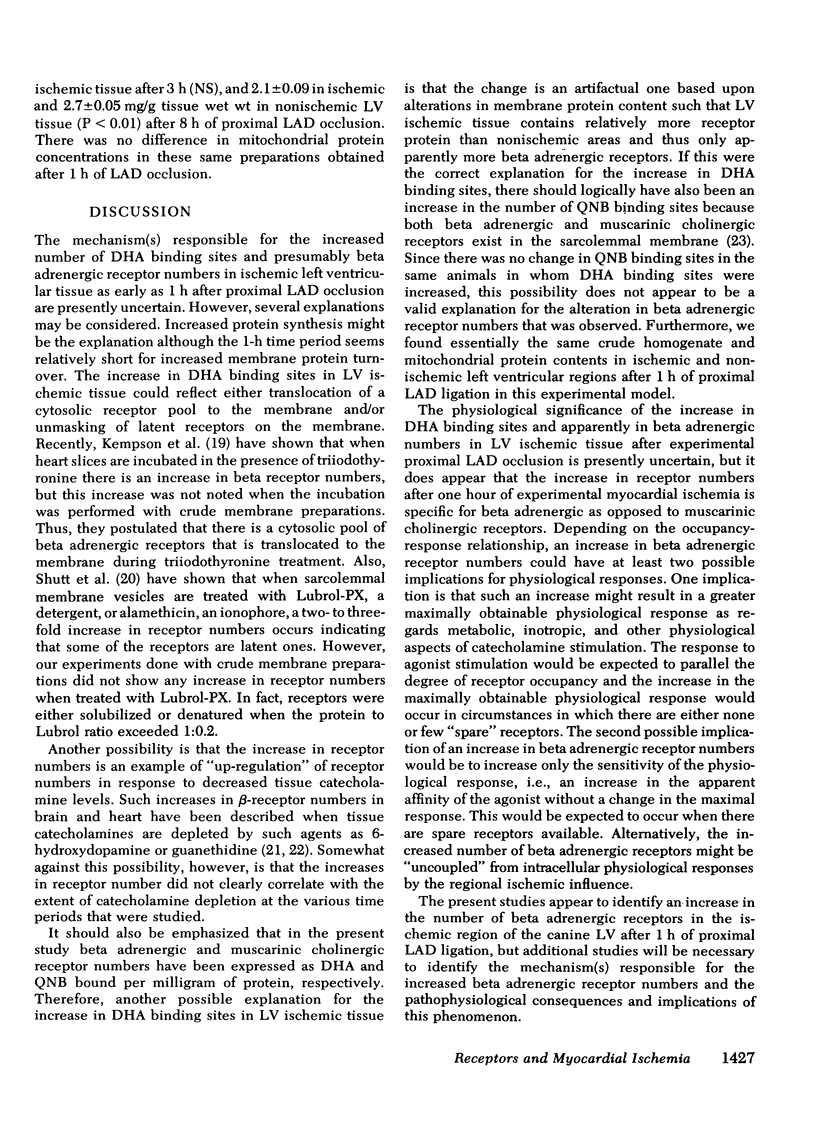
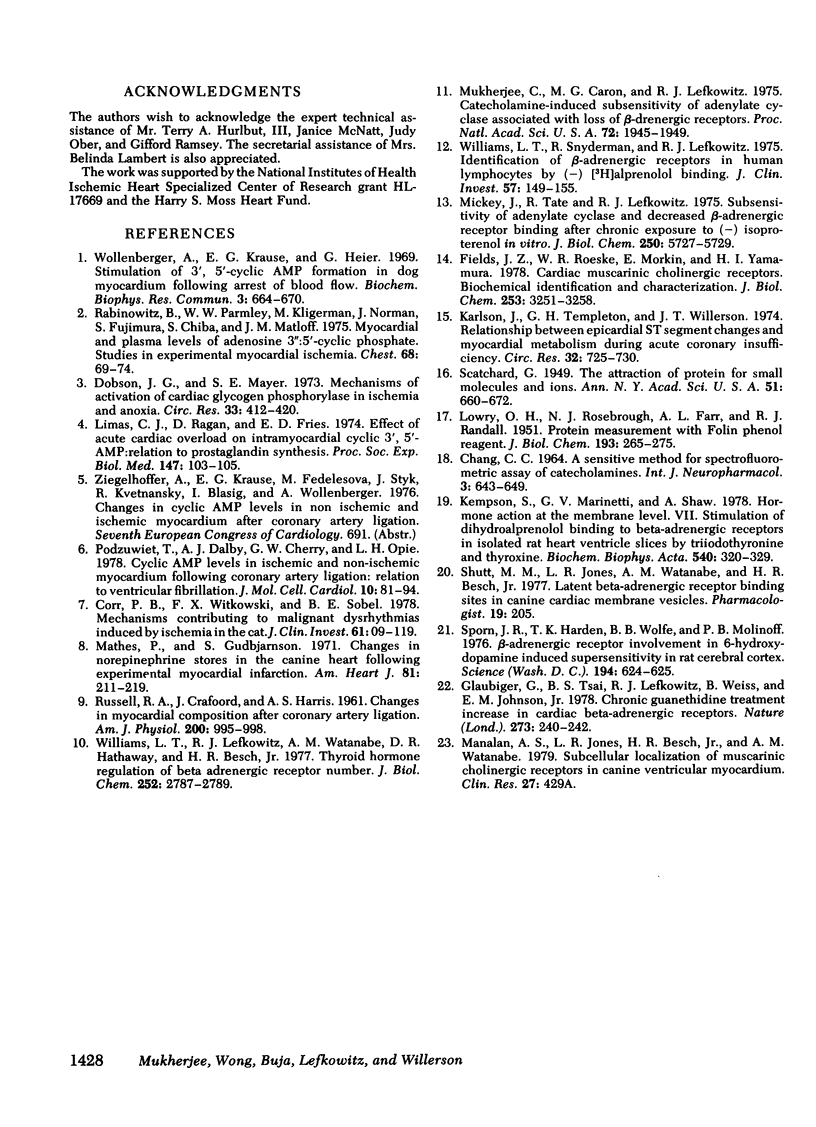
Selected References
These references are in PubMed. This may not be the complete list of references from this article.
- CHANG C. C. A SENSITIVE METHOD FOR SPECTROPHOTOFLUOROMETRIC ASSAY OF CATECHOLAMINES. Int J Neuropharmacol. 1964 Dec;3:643–649. doi: 10.1016/0028-3908(64)90089-9. [DOI] [PubMed] [Google Scholar]
- Corr P. B., Witkowski F. X., Sobel B. E. Mechanisms contributing to malignant dysrhythmias induced by ischemia in the cat. J Clin Invest. 1978 Jan;61(1):109–119. doi: 10.1172/JCI108908. [DOI] [PMC free article] [PubMed] [Google Scholar]
- Dobson J. G., Jr, Mayer S. E. Mechanisms of activation of cardiac glycogen phosphorylase in ischemia and anoxia. Circ Res. 1973 Oct;33(4):412–420. doi: 10.1161/01.res.33.4.412. [DOI] [PubMed] [Google Scholar]
- Fields J. Z., Roeske W. R., Morkin E., Yamamura H. I. Cardiac muscarinic cholinergic receptors. Biochemical identification and characterization. J Biol Chem. 1978 May 10;253(9):3251–3258. [PubMed] [Google Scholar]
- Glaubiger G., Tsai B. S., Lefkowitz R. J., Weiss B., Johnson E. M., Jr Chronic guanethidine treatment increases cardiac beta-adrenergic receptors. Nature. 1978 May 18;273(5659):240–242. doi: 10.1038/273240a0. [DOI] [PubMed] [Google Scholar]
- Karlsson J., Templeton G. H., Willerson J. T. Relationship between epicardial S-T segment changes and myocardial metabolism during acute coronary insufficiency. Circ Res. 1973 Jun;32(6):725–730. doi: 10.1161/01.res.32.6.725. [DOI] [PubMed] [Google Scholar]
- Kempson S., Marinetti G. V., Shaw A. Hormone action at the membrane level. VII. Stimulation of dihydroalprenolol binding to beta-adrenergic receptors in isolated rat heart ventricle slices by triiodothyronine and thyroxine. Biochim Biophys Acta. 1978 May 3;540(2):320–329. doi: 10.1016/0304-4165(78)90145-9. [DOI] [PubMed] [Google Scholar]
- LOWRY O. H., ROSEBROUGH N. J., FARR A. L., RANDALL R. J. Protein measurement with the Folin phenol reagent. J Biol Chem. 1951 Nov;193(1):265–275. [PubMed] [Google Scholar]
- Limas C. J., Ragan D., Freis E. D. Effect of acute cardiac overload on intramyocardial cyclic 3',5'-AMP: relation to prostaglandin synthesis. Proc Soc Exp Biol Med. 1974 Oct;147(1):103–105. doi: 10.3181/00379727-147-38289. [DOI] [PubMed] [Google Scholar]
- Mathes P., Gudbjarnason S. Changes in norepinephrine stores in the canine heart following experimental myocardial infarction. Am Heart J. 1971 Feb;81(2):211–219. doi: 10.1016/0002-8703(71)90131-1. [DOI] [PubMed] [Google Scholar]
- Mickey J., Tate R., Lefkowitz R. J. Subsensitivity of adenylate cyclase and decreased beta-adrenergic receptor binding after chronic exposure to (minus)-isoproterenol in vitro. J Biol Chem. 1975 Jul 25;250(14):5727–5729. [PubMed] [Google Scholar]
- Mukherjee C., Caron M. G., Lefkowitz R. J. Catecholamine-induced subsensitivity of adenylate cyclase associated with loss of beta-adrenergic receptor binding sites. Proc Natl Acad Sci U S A. 1975 May;72(5):1945–1949. doi: 10.1073/pnas.72.5.1945. [DOI] [PMC free article] [PubMed] [Google Scholar]
- Podzuweit T., Dalby A. J., Cherry G. W., Opie L. H. Cyclic AMP levels in ischaemic and non-ischaemic myocardium following coronary artery ligation: relation to ventricular fibrillation. J Mol Cell Cardiol. 1978 Jan;10(1):81–94. doi: 10.1016/0022-2828(78)90008-1. [DOI] [PubMed] [Google Scholar]
- RUSSELL R. A., CRAFOORD J., HARRIS A. S. Changes in myocardial composition after coronary artery ligation. Am J Physiol. 1961 May;200:995–998. doi: 10.1152/ajplegacy.1961.200.5.995. [DOI] [PubMed] [Google Scholar]
- Rabinowitz B., Parmley W. W., Kligerman M., Norman J., Fujimura S., Chiba S., Matloff J. M. Myocardial and plasma levels of adenosine 3':5'-cyclic phosphate. Studies in experimental myocardial ischemia. Chest. 1975 Jul;68(1):69–74. doi: 10.1378/chest.68.1.69. [DOI] [PubMed] [Google Scholar]
- Sporn J. R., Harden T. K., Wolfe B. B., Molinoff P. B. beta-Adrenergic receptor involvement in 6-hydroxydopamine-induced supersensitivity in rat cerebral cortex. Science. 1976 Nov 5;194(4265):624–626. doi: 10.1126/science.10626. [DOI] [PubMed] [Google Scholar]
- Williams L. T., Lefkowitz R. J., Watanabe A. M., Hathaway D. R., Besch H. R., Jr Thyroid hormone regulation of beta-adrenergic receptor number. J Biol Chem. 1977 Apr 25;252(8):2787–2789. [PubMed] [Google Scholar]
- Williams L. T., Snyderman R., Lefkowitz R. J. Identification of beta-adrenergic receptors in human lymphocytes by (-) (3H) alprenolol binding. J Clin Invest. 1976 Jan;57(1):149–155. doi: 10.1172/JCI108254. [DOI] [PMC free article] [PubMed] [Google Scholar]
- Wollenberger A., Krause E. G., Heier G. Stimulation of 3',5'-cyclic AMP formation in dog myocardium following arrest of blood flow. Biochem Biophys Res Commun. 1969 Aug 15;36(4):664–670. doi: 10.1016/0006-291x(69)90357-x. [DOI] [PubMed] [Google Scholar]


